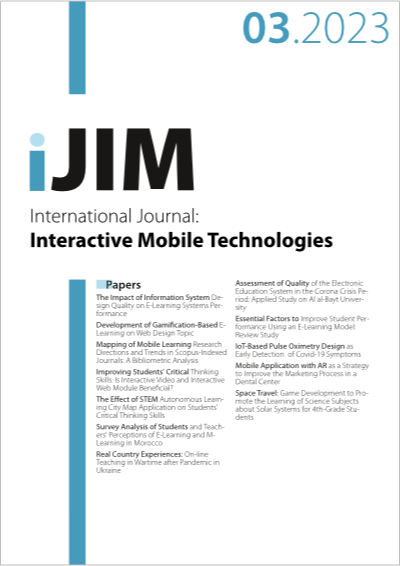IoT-Based Pulse Oximetry Design as Early Detection of Covid-19 Symptoms
DOI:
https://doi.org/10.3991/ijim.v17i03.35859Keywords:
Covid-19, Oxygen Detection, happy hypoxia, IoT, Pulse OximetryAbstract
Covid-19 patients experience several symptoms such as shortness of breath, abnormal heart rate, lung function abnormalities that are similar to pneumonia symptoms. These symptom conditions indicate that the saturation of oxygen (O2) levels dissolved in the blood is not normal. To measure oxygen levels in the blood using a medical device, one of which is a Pulse Oximeter. Covid-19 patients in the Sapta Taruna Health Center were 665 patients, of which this patient was counted from January 2022 to April 2022. Based on information obtained from the Sapta Taruna Health Center, the only patients that were counted were those who did the PCR/Swab test, while the people who were suspected infected with Covid-19 there are still many who do not do PCR/Swab tests, this refusal is due to fear because Hoax information is spread in the community such as: PCR/Swab tests are painful, if the PCR/Swab test results are positive, fear of being ostracized, feel healthy and other reasons. other. Patients who have been tested positive for Covid-19 will be given drugs such as fever medicine, antibiotics, anti-virus, Vitamin C, and others according to the level of symptoms they feel, if the symptoms are felt at a moderate, mild or even asymptomatic stage, they will be advised to isolate independently (Isoma) at home, but there is no further monitoring from the Sapta Taruna Health Center, even though patients who are self-isolating at home may experience a decrease in blood oxygen levels drastically, so these patients need medical devices such as pulse oximetry so that patients who are isoma can perform independent checking, henceforth the current pulse oximetry cannot provide remote information related to the condition of oxygen saturation in the patient's blood. Judging from the problems above, the research team made a product, namely Pulse Oximetry based on IoT, this tool is to measure oxygen saturation in the patient's blood and the data from the measurements made by the patient will be automatically sent to the server and can be viewed on the Sapta Taruna Health Center website, so that the Sapta Taruna Health Center can monitoring the condition of the patient in real time without having to meet directly with the patient.
Downloads
Published
How to Cite
Issue
Section
License
Copyright (c) 2023 Refni Wahyuni, Herianto, Ikhtiyaruddin, Yuda Irawan

This work is licensed under a Creative Commons Attribution 4.0 International License.



